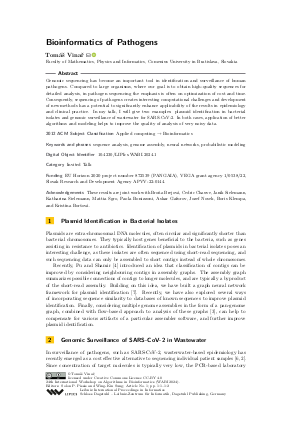Bioinformatics of Pathogens (Invited Talk)
Author
Tomáš Vinař 
-
Part of:
Volume:
24th International Workshop on Algorithms in Bioinformatics (WABI 2024)
Part of: Series: Leibniz International Proceedings in Informatics (LIPIcs)
Part of: Conference: International Conference on Algorithms for Bioinformatics (WABI) - License:
 Creative Commons Attribution 4.0 International license
Creative Commons Attribution 4.0 International license
- Publication Date: 2024-08-26
File

PDF
LIPIcs.WABI.2024.1.pdf
- Filesize: 385 kB
- 2 pages
Document Identifiers
Subject Classification
ACM Subject Classification
- Applied computing → Bioinformatics
Keywords
- sequence analysis
- genome assembly
- neural networks
- probabilistic modeling
Metrics
- Access Statistics
-
Total Accesses (updated on a weekly basis)
0PDF Downloads0Metadata Views
Abstract
Genomic sequencing has become an important tool in identification and surveillance of human pathogens. Compared to large organisms, where our goal is to obtain high-quality sequences for detailed analysis, in pathogen sequencing the emphasis is often on optimization of cost and time. Consequently, sequencing of pathogens creates interesting computational challenges and development of new methods has a potential to significantly enhance applicability of the results in epidemiology and clinical practice. In my talk, I will give two examples: plasmid identification in bacterial isolates and genomic surveillance of wastewater for SARS-CoV-2. In both cases, application of better algorithms and modeling helps to improve the quality of analysis of very noisy data.
Cite As Get BibTex
Tomáš Vinař. Bioinformatics of Pathogens (Invited Talk). In 24th International Workshop on Algorithms in Bioinformatics (WABI 2024). Leibniz International Proceedings in Informatics (LIPIcs), Volume 312, pp. 1:1-1:2, Schloss Dagstuhl – Leibniz-Zentrum für Informatik (2024)
https://doi.org/10.4230/LIPIcs.WABI.2024.1
BibTex
@InProceedings{vinar:LIPIcs.WABI.2024.1,
author = {Vina\v{r}, Tom\'{a}\v{s}},
title = {{Bioinformatics of Pathogens}},
booktitle = {24th International Workshop on Algorithms in Bioinformatics (WABI 2024)},
pages = {1:1--1:2},
series = {Leibniz International Proceedings in Informatics (LIPIcs)},
ISBN = {978-3-95977-340-9},
ISSN = {1868-8969},
year = {2024},
volume = {312},
editor = {Pissis, Solon P. and Sung, Wing-Kin},
publisher = {Schloss Dagstuhl -- Leibniz-Zentrum f{\"u}r Informatik},
address = {Dagstuhl, Germany},
URL = {https://drops.dagstuhl.de/entities/document/10.4230/LIPIcs.WABI.2024.1},
URN = {urn:nbn:de:0030-drops-206455},
doi = {10.4230/LIPIcs.WABI.2024.1},
annote = {Keywords: sequence analysis, genome assembly, neural networks, probabilistic modeling}
}
Author Details
Funding
EU Horizon 2020 project number 872539 (PANGAIA), VEGA grant agency 1/0538/22, Slovak Research and Development Agency APVV-22-0144.
Acknowledgements
These results are joint work with Broňa Brejová, Cedric Chauve, Janik Sielemann, Katharina Sielemann, Mattia Sgro, Paola Bonizzoni, Askar Gafurov, Jozef Nosek, Boris Klempa, and Kristína Boršová.
References
-
A. Gafurov, A. Balaz, F. Amman, K. Borsova, V. Cabanova, B. Klempa, A. Bergthaler, T. Vinar, and B. Brejova. VirPool: model-based estimation of SARS-CoV-2 variant proportions in wastewater samples. BMC Bioinformatics, 23(1):551, 2022.

-
S. E. Hrudey and B. Conant. The devil is in the details: emerging insights on the relevance of wastewater surveillance for SARS-CoV-2 to public health. J Water Health, 20(1):246-270, 2022.

-
A. Mane, M. Faizrahnemoon, T. Vinar, B. Brejova, and C. Chauve. PlasBin-flow: a flow-based MILP algorithm for plasmid contigs binning. Bioinformatics, 39(39 Suppl 1):i288-i296, 2023.

-
L. Pu and R. Shamir. 3CAC: improving the classification of phages and plasmids in metagenomic assemblies using assembly graphs. Bioinformatics, 38(S2):ii56-ii61, 2022.

-
J. Quick, N. D. Grubaugh, S. T. Pullan, I. M. Claro, A. D. Smith, K. Gangavarapu, G. Oliveira, R. Robles-Sikisaka, T. F. Rogers, N. A. Beutler, D. R. Burton, L. L. Lewis-Ximenez, J. G. de Jesus, M. Giovanetti, S. C. Hill, A. Black, T. Bedford, M. W. Carroll, M. Nunes, L. C. Alcantara Jr., E. C. Sabino, S. A. Baylis, N. R. Faria, M. Loose, J. T. Simpson, O. G. Pybus, K. G. Andersen, and N. J. Loman. Multiplex PCR method for MinION and Illumina sequencing of Zika and other virus genomes directly from clinical samples. Nat Protoc, 12(6):1261-1276, 2017.

-
H. R. Safford, K. Shapiro, and H. N. Bischel. Opinion: Wastewater analysis can be a powerful public health tool-if it’s done sensibly. Proc Natl Acad Sci U S A, 119(6), 2022.

-
J. Sielemann, K. Sielemann, B. Brejova, T. Vinar, and C. Chauve. plASgraph2: using graph neural networks to detect plasmid contigs from an assembly graph. Front Microbiol, 14:1267695, 2023.

